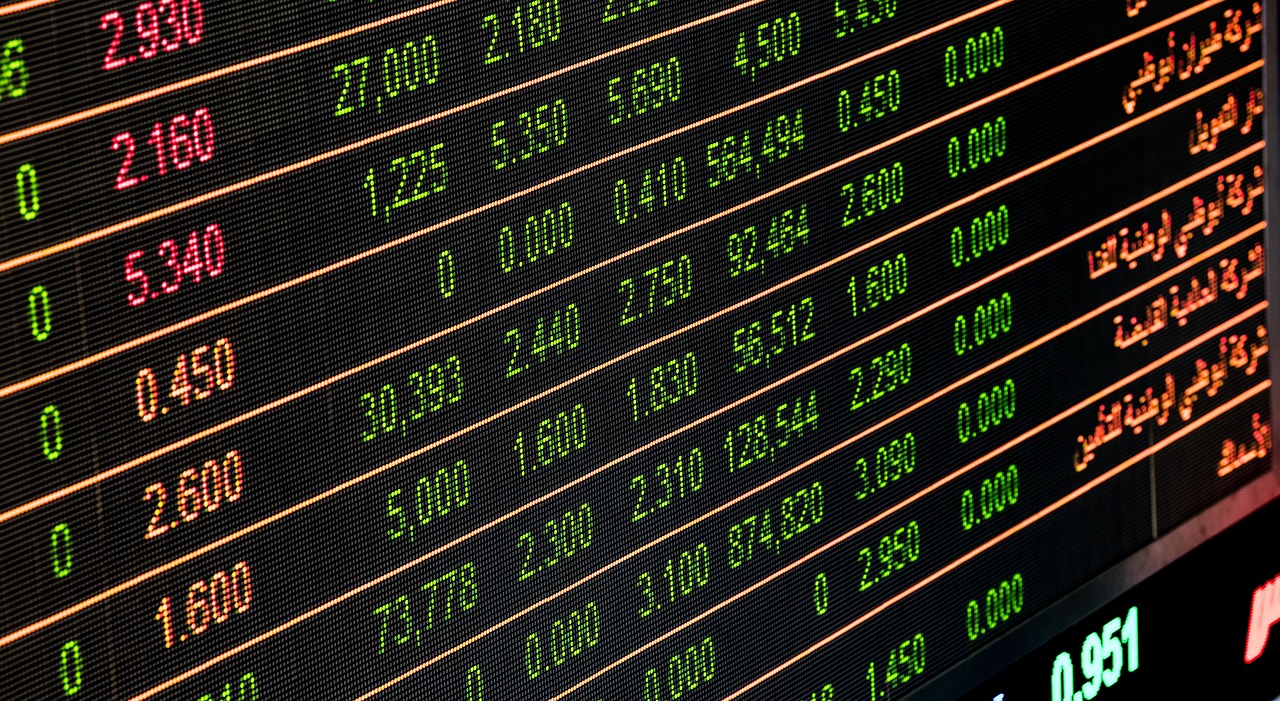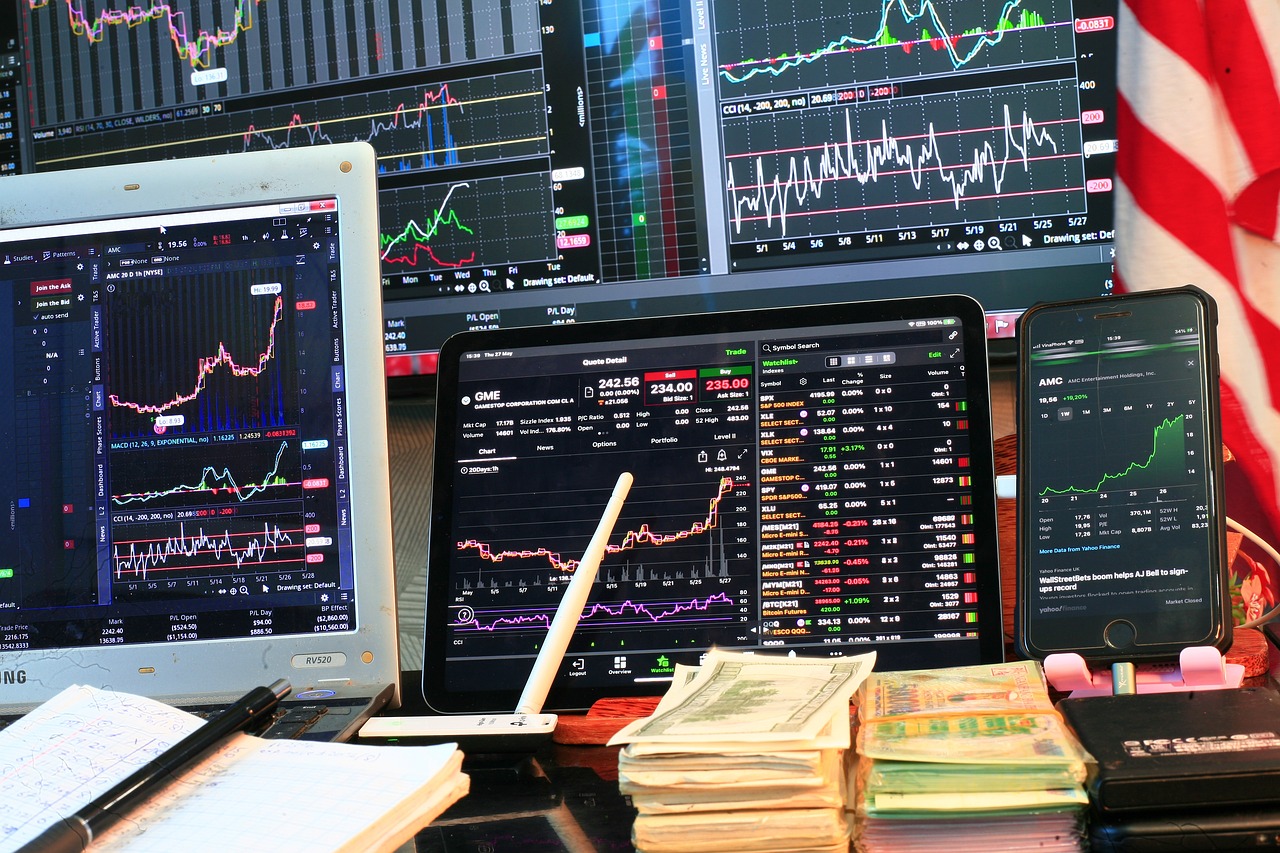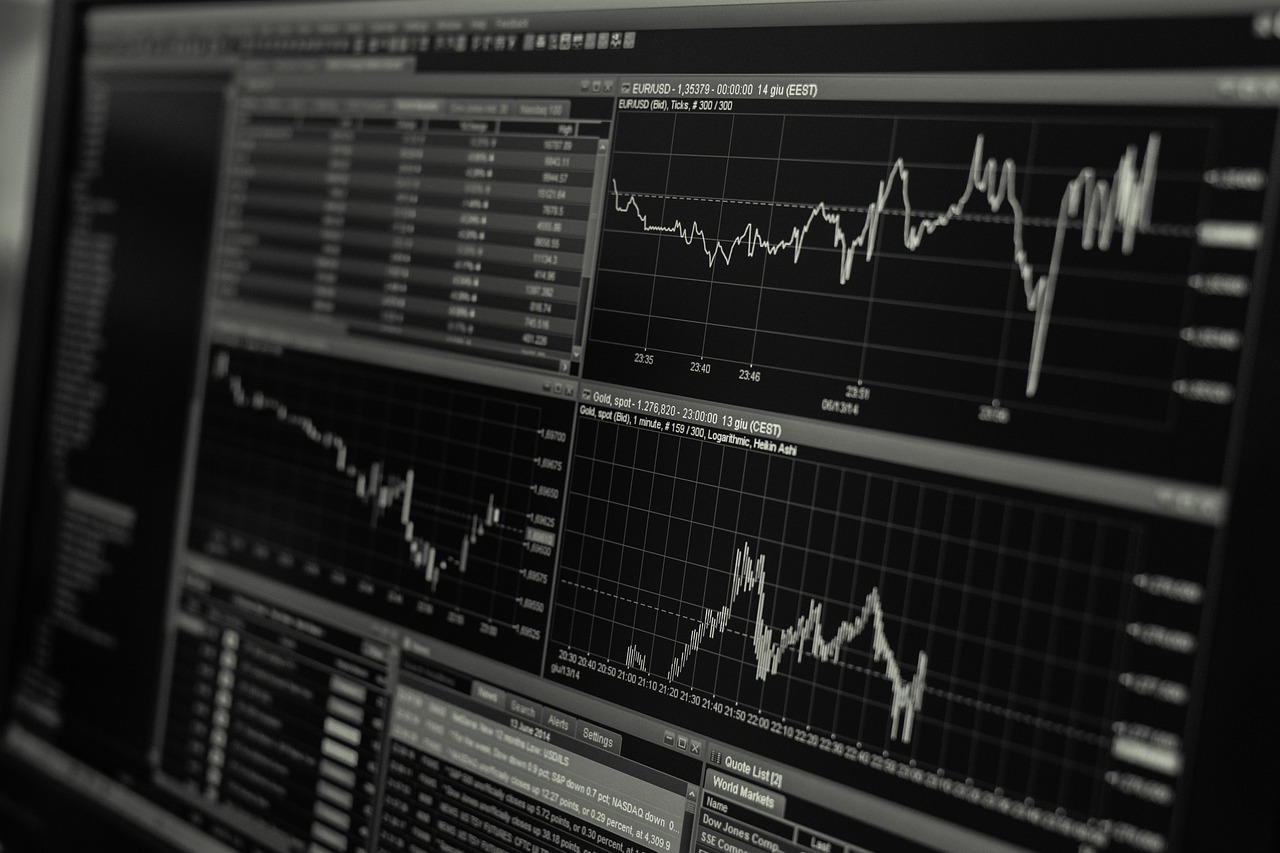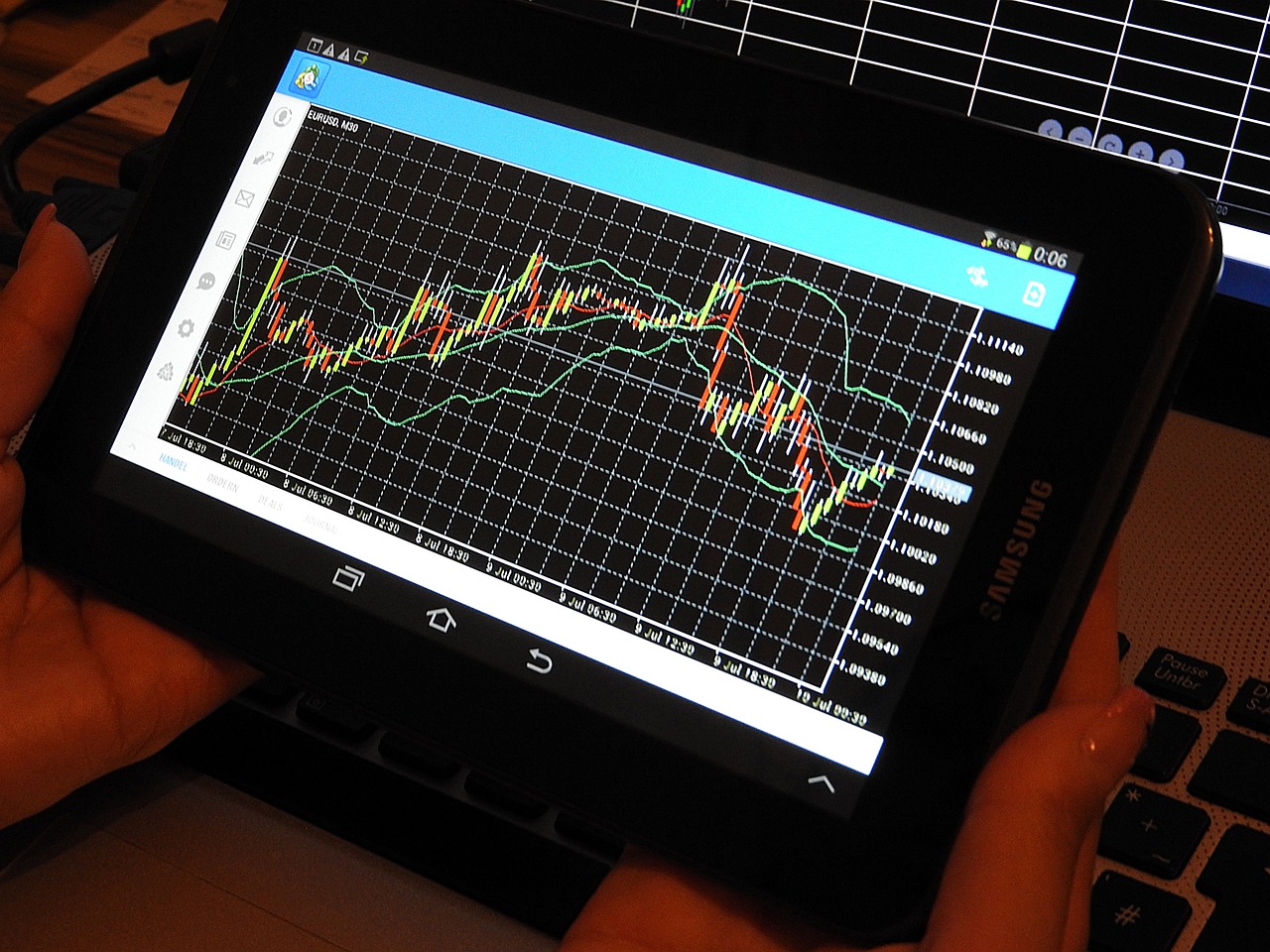Strategies for Trading Cryptocurrencies in Different Markets
In the fast-paced world of cryptocurrency trading, having effective strategies is essential for navigating the complexities of various markets. Whether you're a seasoned pro or a curious newcomer, understanding how to approach trading can significantly enhance your profitability and minimize losses. The cryptocurrency landscape is not just about buying low and selling high; it involves a myriad of factors that influence market dynamics, technical analysis, risk management, and the choice of trading platforms.
First and foremost, it’s crucial to understand that cryptocurrency markets are often volatile and unpredictable. This volatility can be both a blessing and a curse. Imagine riding a rollercoaster; the thrill comes from the ups and downs, but without proper safety measures, you could find yourself in a precarious situation. Similarly, traders need to equip themselves with the right tools and knowledge to ride the waves of the market effectively.
One of the most effective strategies is to conduct thorough market analysis. This involves not just looking at price movements but understanding the underlying factors that drive these changes. For instance, news about regulatory changes, technological advancements, or even social media trends can significantly impact cryptocurrency prices. By staying informed and analyzing these factors, traders can make more educated decisions, allowing them to capitalize on market opportunities.
Moreover, risk management cannot be overlooked. It’s not just about making profits; it’s about protecting your capital. Just as a sailor needs to know how to navigate through storms, traders must have a robust risk management strategy in place. This includes setting stop-loss orders and diversifying their portfolios to mitigate potential losses. By spreading investments across different cryptocurrencies, traders can reduce the impact of a poor-performing asset on their overall portfolio.
Additionally, the choice of trading platform plays a pivotal role in a trader's success. Not all platforms are created equal; some offer advanced features, while others may have higher fees or less security. When selecting a trading platform, it’s essential to consider factors such as user experience, security features, and transaction fees. A user-friendly interface can make trading more efficient, while strong security measures can protect your assets from potential threats.
In conclusion, trading cryptocurrencies requires a blend of knowledge, strategy, and intuition. By understanding market dynamics, utilizing technical and fundamental analysis, and implementing solid risk management practices, traders can position themselves for success in this exciting yet challenging environment. Remember, the key is not just to follow the trends but to anticipate them, making informed decisions that align with your financial goals.
- What is the best strategy for trading cryptocurrencies? The best strategy often varies by individual, but a combination of market analysis, risk management, and technical analysis is generally effective.
- How do I choose the right trading platform? Look for platforms that offer strong security features, low fees, and a user-friendly interface.
- What are stop-loss orders and why are they important? Stop-loss orders are automated instructions to sell an asset when it reaches a certain price, helping to limit potential losses.
- Can I trade cryptocurrencies without prior knowledge? While it's possible, having a solid understanding of market dynamics and trading strategies is crucial for success.

Understanding Market Dynamics
When it comes to trading cryptocurrencies, grasping the intricacies of market dynamics is not just beneficial; it's absolutely essential. Think of the cryptocurrency market as a living organism, constantly evolving and reacting to various stimuli. Price movements can be as unpredictable as the weather, influenced by a multitude of factors, including investor sentiment, global events, and technological advancements. Understanding these dynamics can be the difference between a successful trade and a costly mistake.
One of the most significant aspects of market dynamics is price movements. Prices don’t just fluctuate randomly; they are driven by supply and demand. When more people want to buy a cryptocurrency than sell it, the price goes up. Conversely, if more people want to sell than buy, the price drops. This tug-of-war between buyers and sellers creates market trends that traders can capitalize on. To truly understand these trends, one must also consider the broader market sentiment—how traders feel about a particular cryptocurrency or the market as a whole. For instance, positive news can lead to a surge in buying activity, while negative news can trigger panic selling.
Market trends can be categorized into three main types:
- Uptrends: Characterized by rising prices, where higher highs and higher lows are formed.
- Downtrends: Defined by falling prices, where lower highs and lower lows occur.
- Sideways Trends: When prices move within a horizontal range, indicating indecision among traders.
Additionally, there are various external factors that can influence cryptocurrency valuations. These include regulatory changes, technological advancements, and macroeconomic trends. For example, a government announcement regarding the regulation of cryptocurrencies can lead to significant price swings. Similarly, technological breakthroughs, like improvements in blockchain technology, can enhance the appeal of certain cryptocurrencies, driving up their value. Understanding these external factors can provide traders with a competitive edge, enabling them to anticipate market movements before they happen.
In summary, to navigate the cryptocurrency market successfully, one must develop an acute awareness of market dynamics. By staying informed about price movements, market trends, and external influences, traders can make more informed decisions, ultimately enhancing their profitability. So, the next time you're about to make a trade, ask yourself: What are the underlying forces at play? This mindset can transform your trading strategy from reactive to proactive, setting you on the path to success.

Technical Analysis Tools
When diving into the world of cryptocurrency trading, having a solid grasp of is like having a compass in the wilderness. These tools guide you through the often tumultuous waters of market fluctuations, helping you make informed decisions that can significantly enhance your trading outcomes. From identifying trends to predicting price movements, technical analysis is an essential skill for anyone serious about trading cryptocurrencies.
One of the most popular technical analysis tools is the charting software. Charting platforms allow traders to visualize price movements over time, providing insights into market behavior. These platforms often come equipped with various indicators and tools that help traders analyze past performance and forecast future trends. Some of the widely used charting software includes TradingView, Coinigy, and CryptoCompare, each offering unique features that cater to different trading styles.
Another critical aspect of technical analysis is understanding indicators. Indicators are mathematical calculations based on price and volume, which traders use to identify potential trading opportunities. Some of the most common indicators include:
- Relative Strength Index (RSI): This momentum oscillator measures the speed and change of price movements, helping traders identify overbought or oversold conditions.
- Moving Average Convergence Divergence (MACD): This trend-following momentum indicator shows the relationship between two moving averages of a security's price, helping traders spot potential buy and sell signals.
- Bollinger Bands: These bands provide a relative definition of high and low prices, indicating whether prices are high or low on a relative basis.
Now, let's dive a bit deeper into some of the most effective tools that can aid your trading strategy:
| Tool | Description | Use Case |
|---|---|---|
| Chart Patterns | Visual formations created by the price movements of an asset. | Identifying potential reversals or continuations in the market. |
| Support and Resistance | Price levels where the asset tends to stop and reverse. | Determining entry and exit points for trades. |
| Moving Averages | Averages that smooth out price data to identify trends over a specific period. | Spotting trends and potential reversals. |
Understanding how to interpret these indicators and tools can significantly improve your trading strategy. For instance, combining the RSI with moving averages can provide a more comprehensive view of market conditions, allowing you to make more informed decisions. It’s like having a toolkit where each tool has its own function, but when used together, they create a powerful effect.
In conclusion, mastering technical analysis tools is not just about learning how to use them; it's about understanding how they can inform your trading decisions. As you become more familiar with these tools, you'll find that your ability to read the market improves, leading to better trading outcomes. So, take your time to explore different tools, practice with them, and develop a trading strategy that works for you. Remember, in the fast-paced world of cryptocurrency, knowledge is your greatest ally.

Chart Patterns
When it comes to trading cryptocurrencies, are like the secret language of the market. They tell a story about price movements and can provide traders with invaluable insights into potential future trends. Just imagine walking into a crowded room and being able to read the emotions of everyone there; that's what recognizing chart patterns can do for you in the trading world. By understanding these patterns, you can make informed decisions that could lead to better profitability.
Chart patterns generally fall into two categories: continuation patterns and reversal patterns. Continuation patterns suggest that the current trend will continue, while reversal patterns indicate a potential change in direction. Here are some of the most common patterns you should keep an eye on:
- Head and Shoulders: This pattern typically signals a reversal of the current trend. When you see this formation, it often means a bullish trend is about to turn bearish.
- Double Top and Double Bottom: A double top pattern indicates that prices have hit a resistance level twice and may soon decline, while a double bottom suggests that prices have hit a support level twice and may soon rise.
- Triangles: These can be ascending, descending, or symmetrical. Triangles often indicate a period of consolidation before a breakout in either direction.
Understanding these patterns can significantly enhance your trading strategy. For instance, if you spot a head and shoulders pattern forming, you might want to consider selling your position before the price drops. Conversely, if you notice a double bottom, it could be a great opportunity to buy in before the price rises. The key is to combine this knowledge with other technical indicators to confirm your trading decisions.
Now, let’s talk about the significance of volume in these patterns. Volume is like the heartbeat of the market; it tells you how strong a price movement is. For example, if a breakout occurs on a triangle pattern with high volume, it’s a strong signal that the trend is likely to continue. Conversely, if the breakout happens on low volume, it might be a false signal, and you could end up in a precarious situation.
In summary, chart patterns are essential tools in a trader's toolkit. They not only help you identify potential market movements but also assist you in making more strategic decisions. By mastering these patterns, you can navigate the often turbulent waters of cryptocurrency trading with more confidence and clarity.
Q: How do I identify chart patterns effectively?
A: To identify chart patterns effectively, you should practice analyzing historical price charts and look for recurring formations. Using software tools that highlight these patterns can also help.
Q: Can chart patterns be used in other markets?
A: Absolutely! Chart patterns are not exclusive to cryptocurrencies; they can be applied in stock trading, forex, and other financial markets as well.
Q: Should I rely solely on chart patterns for trading decisions?
A: No, while chart patterns are valuable, it's best to use them in conjunction with other technical indicators and fundamental analysis for more informed trading decisions.

Support and Resistance Levels
Support and resistance levels are fundamental concepts in the realm of cryptocurrency trading that every trader should grasp. Understanding these levels is like having a map in a dense forest; it guides you through the unpredictable terrain of market fluctuations. So, what exactly are support and resistance levels? In simple terms, support refers to a price level where a cryptocurrency tends to stop falling and may even bounce back up, while resistance is the price point where an asset struggles to rise above. Think of support as a safety net and resistance as a ceiling that keeps the price in check.
Identifying these levels is crucial for making informed trading decisions. Traders often use historical price data and charting techniques to pinpoint these areas. Imagine you’re playing a game of basketball; support is like the ground you can always rely on to bounce back from a fall, while resistance is the hoop you’re trying to shoot for. If the price approaches a support level, it’s a signal that buyers are stepping in, creating demand. Conversely, when the price hits a resistance level, it indicates that sellers are becoming more active, creating supply.
To effectively utilize support and resistance levels in your trading strategy, consider the following key points:
- Identifying Support Levels: Look for areas where the price has previously bounced back. These can be determined by examining historical charts and noting where the price repeatedly fails to drop below.
- Recognizing Resistance Levels: Similar to support, resistance levels can be found by observing where the price has struggled to break through in the past. These levels often coincide with previous highs.
- Psychological Levels: Round numbers often serve as psychological barriers for traders. For example, if Bitcoin is trading at $20,000, this number may act as a significant resistance level, as many traders place buy or sell orders around these thresholds.
Moreover, the interaction between support and resistance levels can create trading opportunities. For instance, if a cryptocurrency breaks through a resistance level, it might indicate a strong bullish trend, suggesting that it could continue to rise. On the flip side, if the price falls below a support level, it may signal a bearish trend, prompting traders to reconsider their positions. This dynamic nature of support and resistance levels makes them a vital part of any trader's toolkit.
Incorporating support and resistance levels into your trading strategy not only enhances your ability to make informed decisions but also helps in managing risk. By setting your entry and exit points around these levels, you can better control your trades and potentially increase your profitability. Just remember, like any strategy, it’s essential to combine these levels with other analysis tools for a comprehensive approach to trading.
What are support and resistance levels?
Support and resistance levels are price points on a chart where the price tends to stop and reverse direction. Support is where prices stop falling, while resistance is where prices stop rising.
How can I identify support and resistance levels?
You can identify these levels by analyzing historical price data and looking for points where the price has bounced back or struggled to break through in the past.
Why are support and resistance levels important in trading?
These levels help traders make informed decisions about when to enter or exit trades, manage risk, and identify potential price movements in the market.
Can support and resistance levels change?
Yes, support and resistance levels can change as market conditions evolve. A previous support level can become a resistance level if the price breaks below it, and vice versa.

Moving Averages
are one of the most widely utilized tools in the realm of technical analysis, providing traders with a clearer picture of market trends by smoothing out price fluctuations over a specified period. They help in identifying the direction of the trend and can be particularly useful in determining potential entry and exit points. Imagine trying to navigate through a foggy landscape; moving averages act as your compass, guiding you through the uncertainty of price movements.
There are several types of moving averages, each with its unique characteristics and applications. The two most common types are the Simple Moving Average (SMA) and the Exponential Moving Average (EMA). The SMA calculates the average price over a set number of periods, making it a straightforward tool for traders. For instance, a 50-day SMA takes the closing prices of the last 50 days and divides that sum by 50. This method, while easy to understand, can sometimes lag behind current price action.
On the other hand, the EMA gives more weight to recent prices, which makes it more responsive to new information. This characteristic can be advantageous in fast-moving markets where timely decisions are crucial. Traders often use both types of moving averages in conjunction to create a more comprehensive trading strategy. For example, a common approach is to look for crossover signals, where a shorter-term EMA crosses above or below a longer-term SMA. Such crossovers can indicate potential buy or sell signals, acting as a beacon in the turbulent waters of cryptocurrency trading.
To illustrate the differences between these moving averages, consider the following table:
| Type of Moving Average | Calculation Method | Responsiveness |
|---|---|---|
| Simple Moving Average (SMA) | Averages a set number of past prices | Less responsive to recent price changes |
| Exponential Moving Average (EMA) | Gives more weight to recent prices | More responsive to recent price changes |
When utilizing moving averages, it's essential to consider the period you choose for your analysis. Shorter periods, such as the 10-day or 20-day moving averages, can provide quick signals but may also produce false positives. Conversely, longer periods, like the 100-day or 200-day moving averages, can offer more reliable signals but may delay your trading decisions. Finding the right balance is crucial, and this often comes down to personal trading style and risk tolerance.
Ultimately, moving averages are a powerful tool in a trader's arsenal, but they should not be used in isolation. It's vital to combine them with other indicators and analysis techniques to enhance decision-making. For instance, pairing moving averages with relative strength index (RSI) or MACD can provide a more rounded view of market conditions, helping traders make more informed choices. Just like a chef wouldn't rely solely on one ingredient to create a dish, traders should blend various tools and strategies for the best results.
- What is the main purpose of moving averages in trading?
Moving averages help traders identify trends and potential reversal points by smoothing out price data over a specific period.
- How do I choose the right period for a moving average?
The right period depends on your trading strategy; shorter periods provide quicker signals, while longer periods offer more stability.
- Can moving averages predict future prices?
While moving averages can indicate trends, they do not predict future prices with certainty. They should be used in conjunction with other analysis tools.

Fundamental Analysis Considerations
When diving into the world of cryptocurrency trading, understanding fundamental analysis is like having a treasure map. It guides you through the often turbulent waters of market fluctuations by focusing on the intrinsic value of a cryptocurrency. Unlike technical analysis, which is all about charts and patterns, fundamental analysis digs deeper, examining the very essence of the cryptocurrency itself. So, what should you look for? Let’s break it down.
First and foremost, it’s crucial to consider the project fundamentals. What is the purpose of the cryptocurrency? Does it solve a real-world problem? For instance, Bitcoin was created as a decentralized alternative to traditional currencies, while Ethereum aims to facilitate smart contracts and decentralized applications. Understanding these fundamentals can give you insights into whether a cryptocurrency is likely to gain traction or fade into obscurity.
Next, you need to keep your finger on the pulse of market sentiment. This is where the emotional aspect of trading comes into play. Social media platforms, forums, and news outlets can dramatically influence how investors perceive a cryptocurrency. A single tweet from a prominent figure can send prices soaring or plummeting. Therefore, it's essential to stay updated on the latest news and community discussions surrounding your chosen cryptocurrencies.
Moreover, regulatory news plays a significant role in shaping the landscape of cryptocurrency trading. Governments around the world are still figuring out how to approach cryptocurrencies, and their regulations can either bolster a coin’s legitimacy or create significant hurdles. For example, when China announced a crackdown on cryptocurrency trading, many coins experienced sharp declines. Keeping an eye on regulatory developments is crucial for making informed decisions.
To sum it up, fundamental analysis is not just a checklist; it’s a comprehensive approach to understanding what drives the value of cryptocurrencies. By focusing on project fundamentals, market sentiment, and regulatory news, you can develop a well-rounded view that enhances your trading strategy. This approach not only helps in identifying potential winners but also aids in avoiding the pitfalls of speculative trading.
- What is fundamental analysis in cryptocurrency trading?
Fundamental analysis involves evaluating the intrinsic value of a cryptocurrency by examining its project fundamentals, market sentiment, and regulatory environment. - Why is market sentiment important?
Market sentiment reflects the emotions and attitudes of investors, which can significantly impact cryptocurrency prices. Staying aware of sentiment can help traders make better decisions. - How does regulatory news affect cryptocurrency?
Regulatory news can either enhance or hinder the legitimacy of a cryptocurrency, directly influencing its market value and investor confidence.

Risk Management Strategies
When it comes to trading cryptocurrencies, one of the most critical aspects that can determine your success is risk management. Just like a seasoned sailor navigating through turbulent waters, traders need to have a robust plan to safeguard their investments from the unpredictable waves of the crypto market. Effective risk management strategies not only help minimize losses but also enhance your potential for long-term profitability. So, how can you effectively manage risk in your trading endeavors?
First off, it’s essential to understand that not all trades are created equal. Each trade comes with its own set of risks, and the key to managing these risks lies in diversifying your portfolio. Diversification acts like a safety net; it spreads your investments across various cryptocurrencies, reducing the impact of a downturn in any single asset. For example, if you invest in a mix of established coins like Bitcoin and Ethereum, along with some altcoins, you can cushion the blow if one of them takes a nosedive. In fact, a well-diversified portfolio can significantly lower your overall risk exposure.
Another vital component of risk management is the use of stop-loss orders. Think of a stop-loss order as your personal safety parachute; it’s there to catch you when the market takes a steep dive. By setting a stop-loss order at a predetermined price, you can automatically sell a cryptocurrency when it drops to that level, thereby limiting your losses. For instance, if you buy a coin at $100 and set a stop-loss at $90, your loss is capped at $10. This practice ensures that you don’t experience catastrophic losses that could wipe out your trading capital.
Moreover, it’s crucial to determine your risk tolerance before entering any trade. This involves assessing how much of your capital you are willing to risk on a single trade. A common rule of thumb is to risk no more than 1-2% of your total trading capital on any given trade. This way, even a series of unfortunate trades won’t significantly impact your overall portfolio. For instance, if your trading capital is $10,000, risking 2% means you would only risk $200 on a single trade. This approach helps you stay in the game longer and allows for recovery from losses.
To further illustrate these strategies, let’s take a look at a simple
| Risk Management Technique | Description | Benefits |
|---|---|---|
| Diversification | Spreading investments across various cryptocurrencies | Reduces the impact of a single asset's poor performance |
| Stop-Loss Orders | Automatic sell orders set at a specific price | Limits losses and protects capital |
| Risk Tolerance Assessment | Determining how much of your capital to risk per trade | Ensures that you stay within your comfort zone |
In conclusion, effective risk management strategies are essential for anyone looking to trade cryptocurrencies successfully. By diversifying your portfolio, setting stop-loss orders, and assessing your risk tolerance, you can significantly enhance your chances of long-term success in this volatile market. Remember, trading isn’t just about making profits; it’s also about protecting what you already have. So, are you ready to take control of your trading journey?
- What is the best way to manage risk in cryptocurrency trading?
The best way to manage risk is by diversifying your portfolio, using stop-loss orders, and assessing your risk tolerance before making trades. - How much capital should I risk on a single trade?
A common guideline is to risk no more than 1-2% of your total trading capital on any single trade. - Can diversification really help reduce risk?
Yes, diversification spreads your investments across different assets, which can cushion the impact of a downturn in any single asset. - What is a stop-loss order?
A stop-loss order is an automatic sell order set at a predetermined price to limit potential losses in trading.

Diversification Techniques
When it comes to trading cryptocurrencies, diversification is one of the most effective strategies for managing risk. Think of your cryptocurrency portfolio as a garden; if you plant only one type of flower, a single pest or drought can wipe out your entire investment. However, by planting a variety of flowers, you increase the chances that at least some will thrive, even in adverse conditions. This principle applies directly to cryptocurrency trading, where the market can be volatile and unpredictable.
To effectively diversify your cryptocurrency portfolio, consider the following techniques. First, it’s essential to invest in a mix of established cryptocurrencies, such as Bitcoin and Ethereum, alongside emerging altcoins. Established coins typically have lower volatility and can provide a stable foundation for your portfolio. On the other hand, altcoins might offer higher growth potential, albeit with increased risk. This balance can help cushion your investments against market fluctuations.
Another technique is to diversify across different sectors within the cryptocurrency space. For instance, you might invest in:
- DeFi (Decentralized Finance) projects, which aim to recreate traditional financial systems on the blockchain.
- NFT (Non-Fungible Tokens) platforms, which have gained immense popularity for their unique digital assets.
- Stablecoins, which are pegged to traditional currencies and can provide stability during market downturns.
Furthermore, consider the geographical diversification of your investments. Cryptocurrencies are not limited by borders, and different regions may experience unique market conditions. Investing in projects based in various countries can mitigate risks associated with regulatory changes or economic downturns in a specific region.
It’s also wise to regularly review and rebalance your portfolio. As market conditions change, some assets may outperform others, leading to an unintentional concentration of risk. By periodically assessing your holdings and adjusting them to maintain your desired level of diversification, you can stay aligned with your investment goals.
In conclusion, diversification is not just a safety net; it’s a proactive strategy that can enhance your trading success. By spreading your investments across different cryptocurrencies, sectors, and regions, you can better navigate the turbulent waters of the crypto market. Remember, the key is to find a balance that aligns with your risk tolerance and investment objectives. Now that you have a grasp on diversification techniques, are you ready to cultivate your own crypto garden?
Q: What is diversification in cryptocurrency trading?
A: Diversification in cryptocurrency trading involves spreading your investments across different cryptocurrencies and sectors to reduce risk and enhance potential returns.
Q: Why is it important to diversify my cryptocurrency portfolio?
A: Diversifying your portfolio helps protect against market volatility. If one asset performs poorly, others may perform well, balancing out potential losses.
Q: How often should I rebalance my cryptocurrency portfolio?
A: It’s advisable to review and rebalance your portfolio at least once every few months or whenever there are significant changes in the market or your investment strategy.
Q: Can I diversify with a small investment?
A: Yes, you can still diversify with a small investment by choosing lower-cost cryptocurrencies or fractional shares of larger coins. It’s about spreading your risk, not the amount you invest.

Setting Stop-Loss Orders
When it comes to trading cryptocurrencies, one of the most effective strategies to protect your investments is by . A stop-loss order is essentially a safety net; it automatically sells your cryptocurrency when it reaches a predetermined price, helping you to limit your losses. Imagine you're on a roller coaster, and you feel the thrill of the ride, but you also want to know that there's a way to safely get off if things go sideways. That's what a stop-loss order does for your trading journey.
To effectively set a stop-loss order, you first need to determine your risk tolerance. This means understanding how much of your investment you are willing to lose before you pull the plug. For instance, if you buy Bitcoin at $50,000 and decide that you can tolerate a 10% drop, you would set your stop-loss order at $45,000. This way, if the market takes a downturn and your investment falls to that level, the order triggers, and your Bitcoin is sold automatically, preventing further losses.
Another crucial aspect of setting stop-loss orders is choosing the right type. There are generally two types of stop-loss orders: fixed stop-loss and trailing stop-loss. A fixed stop-loss remains at a set price, while a trailing stop-loss adjusts as the price of the cryptocurrency increases. For example, if you set a trailing stop-loss at 10% below the market price, and the price of Bitcoin rises to $60,000, your stop-loss would automatically adjust to $54,000. This allows you to lock in profits while still protecting against potential downturns.
It's also important to consider market conditions when setting your stop-loss. In a highly volatile market, prices can swing dramatically, and a stop-loss set too close to the market price might result in unnecessary sell-offs. Therefore, many traders recommend placing stop-loss orders at a reasonable distance from the current price, taking into account the cryptocurrency's historical volatility. This strategy can help you avoid being stopped out during minor price fluctuations while still offering protection against larger downturns.
To illustrate how this works, let’s take a look at a simple table comparing fixed and trailing stop-loss orders:
| Type of Stop-Loss | Description | Advantages | Disadvantages |
|---|---|---|---|
| Fixed Stop-Loss | Sells at a predetermined price point. | Simple to set and understand. | May lead to selling during temporary dips. |
| Trailing Stop-Loss | Adjusts the sell point as the price rises. | Locks in profits while allowing for upward movement. | Requires more monitoring and can be complex. |
In conclusion, setting stop-loss orders is a vital part of any cryptocurrency trading strategy. By understanding your risk tolerance, choosing the right type of stop-loss, and considering market conditions, you can effectively protect your investments and enhance your trading experience. Remember, the goal is not just to avoid losses but to create a trading strategy that allows you to participate in the exciting world of cryptocurrencies with a safety net in place.
- What is a stop-loss order? A stop-loss order is an automatic sell order placed to limit potential losses on an investment.
- How do I determine the right stop-loss level? Your stop-loss level should be based on your risk tolerance and market volatility.
- Can I change my stop-loss order? Yes, you can adjust your stop-loss order at any time based on market conditions or your trading strategy.
- Are stop-loss orders guaranteed? No, in volatile markets, there is a risk of slippage, meaning your order may not execute at the exact price you set.

Choosing the Right Trading Platform
When it comes to trading cryptocurrencies, the platform you choose can make or break your trading experience. It's like picking the right vehicle for a long road trip; you wouldn't want to be stuck in a clunky old car when you could be cruising in a sleek, efficient ride. A good trading platform not only enhances your trading capabilities but also provides a secure environment for your investments. So, what should you look for in a trading platform? Let’s break it down.
First and foremost, security features are non-negotiable. In the crypto world, where hacks and scams are all too common, a platform with robust security measures is essential. Look for platforms that offer two-factor authentication, cold storage for assets, and a solid reputation for safeguarding user funds. After all, you wouldn’t leave your front door unlocked, would you?
Next, consider the user experience. A platform should be intuitive and easy to navigate. If you find yourself lost in a maze of buttons and charts, it can lead to costly mistakes. Many platforms offer demo accounts, allowing you to test the waters before diving in. Take advantage of these to find a platform that feels right for you. Additionally, check how the platform performs on mobile devices. With the rise of mobile trading, having a responsive app can be a game-changer.
Another crucial aspect is the fee structure. Different platforms have varying fees for trading, withdrawals, and deposits. It's important to understand how these fees will impact your profitability. For instance, some platforms might advertise low trading fees but charge high withdrawal fees. Always read the fine print! A transparent fee structure can save you a lot of headaches down the line.
| Platform | Trading Fees | Withdrawal Fees | Security Features |
|---|---|---|---|
| Platform A | 0.1% | $1 | 2FA, Cold Storage |
| Platform B | 0.2% | 0.5% | 2FA, Insurance Fund |
| Platform C | 0.15% | $0.5 | 2FA, Multi-Signature Wallets |
Finally, don’t overlook the importance of customer support. In the fast-paced world of cryptocurrency trading, having access to responsive and knowledgeable support can be invaluable. Whether you encounter a technical issue or have a question about a specific feature, you want to know that help is just a click away. Check if the platform offers multiple channels for support, such as live chat, email, or phone support. A platform that prioritizes customer service can make your trading experience much smoother.
In conclusion, choosing the right trading platform is a critical step in your cryptocurrency trading journey. By focusing on security, user experience, fees, and customer support, you can find a platform that not only meets your needs but also enhances your trading potential. Remember, a well-chosen platform is like a trusty compass guiding you through the turbulent waters of the crypto market.
- What should I prioritize when choosing a trading platform? Security features, user experience, fee structure, and customer support are key factors.
- Are all trading platforms secure? No, always research and choose platforms with robust security measures.
- Can I trade cryptocurrencies on my mobile device? Many platforms offer mobile apps, but ensure they provide a good user experience.
- How can I test a trading platform before committing? Look for platforms that offer demo accounts for practice trading.

Security Features
When it comes to trading cryptocurrencies, the importance of cannot be overstated. With the rise of digital currencies, the number of scams, hacks, and fraudulent activities has also increased, making it vital for traders to choose platforms that prioritize their safety. So, what should you look for in a trading platform to ensure your assets are well-protected?
First and foremost, two-factor authentication (2FA) is a must-have feature. This added layer of security requires users to provide two forms of identification before accessing their accounts, significantly reducing the risk of unauthorized access. Additionally, platforms that offer multi-signature wallets allow multiple keys to authorize a transaction, making it much harder for hackers to steal funds.
Another critical aspect is the platform's encryption protocols. Look for exchanges that use industry-standard encryption methods to protect your personal and financial information. A platform that regularly updates its security measures and undergoes external audits demonstrates a commitment to safeguarding user data.
Furthermore, it’s wise to check whether the platform has a cold storage system for cryptocurrencies. Cold storage refers to keeping the majority of digital assets offline, away from potential online threats. This is crucial because the less accessible your funds are to the internet, the less likely they are to be compromised. Many reputable exchanges will keep a significant portion of their assets in cold storage to mitigate risks.
Lastly, consider whether the platform has a clear insurance policy for digital assets. Some exchanges insure user funds against theft or hacks, providing an extra layer of peace of mind. It's essential to read the fine print regarding these policies, as they can vary widely between platforms.
In summary, when evaluating the security features of a cryptocurrency trading platform, keep an eye out for:
- Two-factor authentication (2FA)
- Multi-signature wallets
- Encryption protocols
- Cold storage options
- Insurance policies for digital assets
By ensuring that your chosen platform incorporates these security features, you can trade with greater confidence, knowing that your investments are better protected against potential threats.
Q: What is two-factor authentication (2FA)?
A: Two-factor authentication (2FA) is a security measure that requires two forms of identification before granting access to an account, adding an extra layer of protection against unauthorized access.
Q: Why is cold storage important?
A: Cold storage keeps the majority of digital assets offline, making them less vulnerable to online threats such as hacking and phishing attacks.
Q: How can I verify if a platform has an insurance policy?
A: You can usually find information about a platform's insurance policy in the terms of service or FAQ section on their website. It's essential to read these documents carefully.
Q: What should I do if I suspect my account has been compromised?
A: If you suspect any unauthorized access to your account, immediately change your password, enable 2FA if not already done, and contact the platform's customer support for assistance.

User Experience and Fees
When diving into the world of cryptocurrency trading, user experience and fees are two critical factors that can significantly influence your trading success. Imagine walking into a bustling marketplace; if the stalls are disorganized and the vendors are unhelpful, your shopping experience will be less than enjoyable. Similarly, a trading platform with a clunky interface can lead to missed opportunities and frustration. Therefore, it's essential to choose a platform that offers a seamless and intuitive user experience.
A well-designed trading platform should allow you to navigate effortlessly between different sections, whether you're checking your portfolio, placing trades, or analyzing market data. Look for features such as customizable dashboards, easy-to-access trading tools, and responsive customer support. These elements contribute to a smoother trading experience, enabling you to focus on what truly matters—making informed trading decisions.
Now, let’s talk about fees. Just like hidden costs can sneak up on you when shopping, trading fees can eat into your profits if you're not careful. Different platforms have varying fee structures, which can include:
- Trading Fees: These are fees charged for executing trades and can be either a flat rate or a percentage of the trade value.
- Withdrawal Fees: Some platforms charge a fee when you withdraw your funds, which can vary significantly.
- Deposit Fees: While many platforms offer free deposits, some may charge a fee depending on the payment method.
To help you understand how these fees can impact your trading, consider the following table that compares the fee structures of popular cryptocurrency exchanges:
| Exchange | Trading Fee | Withdrawal Fee | Deposit Fee |
|---|---|---|---|
| Exchange A | 0.1% | $0.01 | Free |
| Exchange B | 0.2% | $0.005 | 3% for credit cards |
| Exchange C | 0.15% | $0.02 | Free |
As you can see, even small differences in fees can add up over time, especially for active traders. Therefore, it's crucial to read the fine print and understand each platform's fee structure before committing your funds. A platform with lower fees might seem appealing, but if its user experience is lacking, it could lead to costly mistakes.
In conclusion, never underestimate the importance of user experience and fees when selecting a trading platform. A seamless interface combined with transparent and reasonable fees can make a world of difference in your trading journey. Remember, the goal is to maximize your profits while minimizing any potential headaches along the way.
Q: How do I choose the best trading platform for me?
A: Look for a platform that offers a user-friendly interface, low fees, and robust security features. Consider your trading style and what tools are most important for your trading strategy.
Q: Are trading fees the only costs I should consider?
A: No, you should also consider withdrawal and deposit fees, as these can impact your overall profitability. Always read the fee structure carefully.
Q: Can I change trading platforms later?
A: Yes, you can switch platforms, but be aware of any withdrawal fees and ensure that you have a clear understanding of how to transfer your assets securely.
Frequently Asked Questions
- What are the key strategies for trading cryptocurrencies?
Trading cryptocurrencies effectively requires a mix of market analysis, risk management, and solid trading techniques. Understanding market dynamics, using technical analysis tools, and keeping an eye on fundamental factors can significantly enhance your trading success.
- How can I analyze cryptocurrency market trends?
To analyze market trends, you can employ various technical analysis tools such as chart patterns, moving averages, and support and resistance levels. These tools help you identify potential entry and exit points, as well as predict price movements based on historical data.
- What is the importance of risk management in trading?
Risk management is crucial because it helps you minimize potential losses and protect your capital. By diversifying your portfolio, setting stop-loss orders, and understanding your risk tolerance, you can safeguard your investments against market volatility.
- How do I choose the right trading platform?
Selecting a trading platform involves considering security features, user experience, and fee structures. Look for platforms that offer robust security measures, an intuitive interface, and transparent fee policies to ensure a smooth trading experience.
- What are stop-loss orders and how do they work?
Stop-loss orders are designed to limit your losses by automatically selling your cryptocurrency when it reaches a predetermined price. By setting appropriate stop-loss levels, you can protect your investment from significant downturns in the market.
- Can I diversify my cryptocurrency portfolio?
Absolutely! Diversification is a powerful strategy to reduce risk in trading. By investing in a variety of cryptocurrencies, you can mitigate potential losses from any single asset's poor performance.
- What should I look for in a cryptocurrency exchange?
When evaluating a cryptocurrency exchange, prioritize security features, ease of use, and fee structures. A reliable exchange should have strong security protocols, a user-friendly interface, and reasonable fees to enhance your trading experience.



















